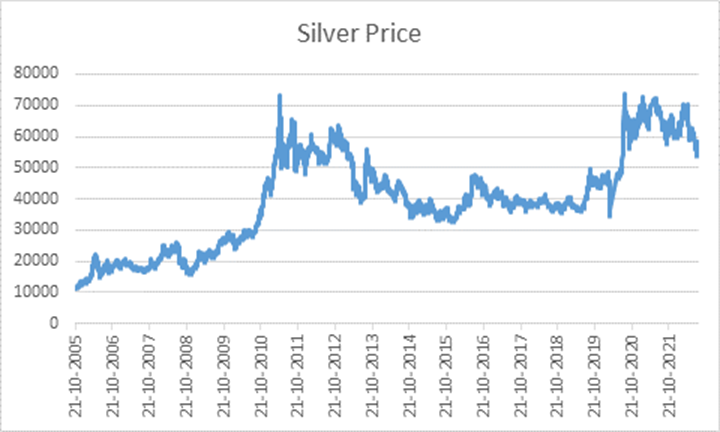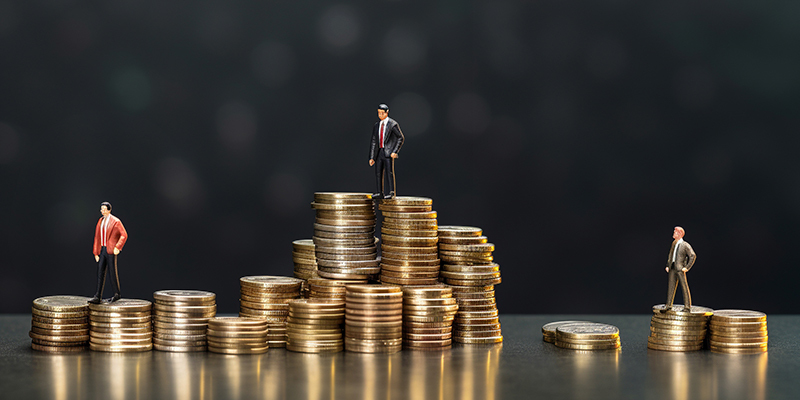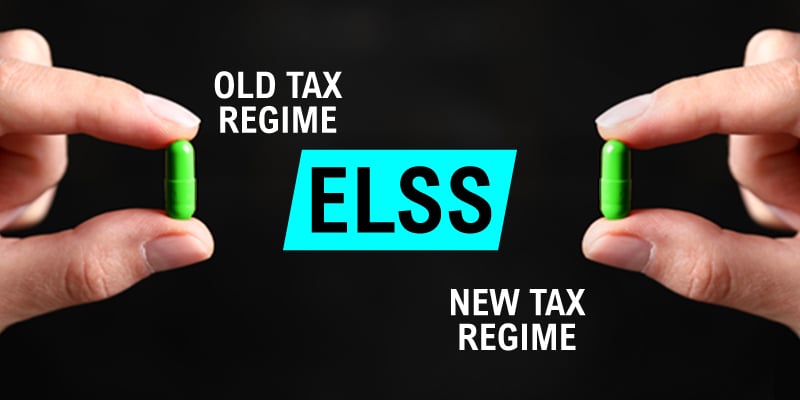Don't Dodge this Silver Bullet!
From Bill Gates to Elon Musk, to the World Bank to Economic analysts - all have been hinting at an impending recession as we move into 2023. The signs are also probably all there - a 40-year record high inflation in the world’s largest economy - The U.S., the IT industry freezing hiring across the globe, jittery stock markets, and the general sense of uneasiness among investors - both foreign and domestic. But dark clouds always come with a silver lining, and presently, it is quite literal.
Silver as an investment avenue has been vying with its yellow metal cousin - Gold - for quite some time now. Silver has stood the test of time as a tangible asset, also borrowing certain investment-pruned features from Gold such as a hedge against inflation (while being a cheaper alternative to gold) and being considered a safe-haven for investors during times of economic turmoil.
“Major monetary metal throughout history is silver, not gold” - Nobel prize winner Milton Friedman (Economist & Statistician)
According to the latest supply and demand report by the Silver Institute, the year 2021 saw a steep rise in the demand for physical silver globally. The demand increased by 19% as compared to 2020.
-jpg.jpeg)
-jpg.jpeg)
On the MCX (Multi-Commodity Exchange), it is seen playing at the psychological barrier of Rs 58,000 as we put out this article.


Source - MCX
Is this the right time to add that silver sheen to your portfolio? Is Silver a good investment? Let's deep dive.
Demand Drivers for Silver
Born with a silver spoon; being born with a silver platter; family silver… Numerous idioms since time immemorial, signify how silver is thought of as a storehouse of value. Classified as a precious metal, silver has been around for centuries.
However, here is a valid question to ask – “When gold is visibly more popular than silver for ornaments and investments, what drives the demand for silver?”
Many cultures worldwide use silver extensively in ornaments to wear at traditional ceremonies. Apart from jewelry, it derives additional value from its electrical conductivity, finding extensive use in photography and electronics. It is both a precious and industrial metal and has a variety of applications such as solar panels, LED lighting, medical devices, etc. Being an essential component of electric vehicles, analysts see lasting demand given the uptick in interest in the EV space in recent times.
(By the way, EVs themselves seem like an interesting investment idea. Read our recent blog on the Rise of EVs)
Here are some applications of silver that serve to potentially increase its demand:-
- Industrial Demand: Silver is used extensively in industrial fabrication. Some areas it finds applications include conductors, switches, contacts, fuses, multi-layer ceramic capacitors, membrane switches, conductive adhesives, etc. Apart from these electronic applications, silver is also used in solar panels, the automotive industry, brazing and soldering, etc.
Fun fact: Silver-coated contacts power all electrical actions in modern cars. This includes operations like opening power windows, starting the engine, power-seat adjustments, etc.
- Jewellery: The gorgeous metal with spectacular sheen and lifetime durability is most popular for its application in jewellery and as silverware. Family heirlooms are traditionally silvers across cultures. According to the Silver Institute’s study, global demand for silver for fabrication into ornaments was 181.4 million ounces in 2021. India saw a 45% jump in demand to 58.7 million ounces
- Bullion: The first use of precious metals like gold and silver in bullion coins and bars dates back to 550 BCE and it is still one of the popular applications of silver. The demand for silver for coins and bars was 205 million ounces in 2020 and it grew by 36% in 2021.
- Silverware: The popularity of silverware has lasted several generations, and cutlery, bowls and decorative items continue to remain in high demand. The year 2021 saw a 32% hike in demand for silver from the silverware industry. India leads the world in silverware offtake at 24.4 million ounces.
These statistics indicate that the demand for silver is high, and it is expected to grow higher as the size of the automobile (especially the EV market) and other industries grow. And as the laws of economics work, when demand increases but supply seems to be limited (Most new silver supplies apart from recycling come from mine-led production, and these capacities are limited), the end outcome is a possible rise in prices.
Can silver be a good investment idea?
Silver is often talked about clubbed with gold- both operate similarly as investments. However, because of its high demand and rare existence in the earth’s crust, gold is a lot more expensive than silver. Investors therefore rely on silver as being the far cheaper alternative to gold as a precious metal.
Another factor to determine whether it is a good investment is its volatility. Silver markets oscillate drastically in the short term. However, if you use silver as your long-term investment strategy, these fluctuations are what can also deliver better returns. (Note: Remember that higher risk could potentially result in better return too, especially over specific cycles)
Of course, physical silver has had its allure for ages, while investors are now gravitating towards digital investments backed by silver.
Here is why silver has value as an avenue for investment with potentially good returns:
- It acts as a hedge against inflation and with its low correlation to stocks, bonds, and other asset classes, it also acts as a good diversifier for your portfolio. When financial advisors talk about diversifying your portfolio, it is not just about adding different types of stocks. It also refers to investing in different asset classes. Silver as a tangible asset, classified as a commodity, can provide essential diversification in the portfolio. This can contribute to designing an all-weather portfolio that has one source of profitability even if all other investments are sailing choppy waters. Based on your long-term investing goals, you can allocate a percentage of your portfolio to silver.
- Silver is regarded as a stable investment in times of economic turmoil, and being a tangible asset, moves divergent from stocks and other securities.
- A not-often considered point- Silver gets adequate attention in the global commodities market, ensuring liquidity.
- There is always a demand for silver because of the multitude of applications in industrial spaces as well as its value as domestic articles - silverware and jewellery, and this demand will continue to rise as we move to more renewable sources of energy.
- Silver is cheaper than gold, so you get more ‘value for money’ in the literal sense.
- Silver has traditionally had great purchasing power, almost at par with gold.
- In one way, it can perhaps be easier to ’time the market’ for silver. The domestic price inevitably goes higher around festivals- but don’t forget don’t base your investment decision just based on this historical precedence.
- Silver can potentially be purchased and traded on the stock exchanges especially in an ETF (Exchange Traded Funds) form- so those who have experience in trading (or at least have demat accounts) or have access to expert advice can also use price fluctuations to their advantage.
- Silver ETFs offer a modern approach to holding silver in the digital form, with the same level of liquidity as physical purchases, but without concerns of storage or risks of theft.
How to invest in Silver?
If you are convinced about the potential of the shiny white metal to diversify your portfolio, the next step is to find the right way to invest in it. You can expose your portfolio to silver in two primary ways. You can either buy it in the physical form or invest in silver-related securities.
Bullion coins, bars, and silver junk bags have remained preferred options for decades now. However, storage issues and expenses often come as a package. Therefore, it could be a more practical approach to turn to financial instruments backed by silver. These include stocks of companies involved with silver mining or streaming, exchange-traded commodities, and exchange-traded funds or mutual funds with silver portfolios. While this approach to silver investment may seem less gratifying emotionally, it combats issues related to holding physical silver. You do not need large storage space, the digital units won’t corrode or tarnish, and there isn’t a chance of theft. Importantly, if there’s ever the time to sell silver to make a profit, holding it as a financial instrument will mean less emotional pain for you (us Indians are quite attached to Gold, Silver and precious metals as you know- we buy saying its an investment, but never end up selling it unless in trouble!)
Is it time to build your silver platter?
While the global economic condition is not very flattering, it seems like the time may be right to consider silver for your investment needs. Why? Because, while fears of a recession are sending jitters across global markets, silver as an investment avenue is finding a footing in recent times. Let’s bring it up here that it is traditional to see investors gravitate towards gold when economic conditions sour.
But here’s an insight that might open up new doors for you - The price of gold rose about 107% during Dec 15 to Mar 22. At the same time, the price of silver rose nearly 110%! (Source: Internal)
The demand for silver is poised to only rise with time as industrial applications expand. A surge in EV demand in automobiles and the full-fledged launch of 5G networks is predicted to take silver prices considerably higher.
Also, silver is a great hedge against inflation that is looming large like a dark cloud over almost every economy in the world. A silver lining, quite literally!
So, what do you think? Did we make a good case? Does silver now sound like something you’d want to consider adding to your portfolio? If yes, click here.
Disclaimer
This note is for information purposes only. In this material DSP Asset Managers Pvt Ltd (the AMC) has used information that is publicly available and is believed to be from reliable sources. While utmost care has been exercised, the author or the AMC does not warrant the completeness or accuracy of the information and disclaims all liabilities, losses and damages arising out of the use of this information. Readers, before acting on any information herein should make their own investigation & seek appropriate professional advice. Any sector(s)/ stock(s)/ issuer(s) mentioned do not constitute any recommendation and the AMC may or may not have any future position in these. All opinions/ figures/ charts/ graphs are as on date of publishing (or as at mentioned date) and are subject to change without notice. Any logos used may be trademarks™ or registered® trademarks of their respective holders, our usage does not imply any affiliation with or endorsement by them.
Past performance may or may not be sustained in the future and should not be used as a basis for comparison with other investments.
Mutual fund investments are subject to market risks, read all scheme related documents carefully.
.png)






Leave a comment